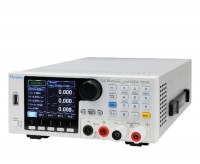-
Battery Simulator Model 17020
- Đăng ngày 27-03-2019 09:29:54 AM - 2690 Lượt xem
- Mã sản phẩm: S000135
-
The 17020 Regenerative Battery Pack Test System equipped with battery charge/discharge motor and battery simulation functions can be used to test battery packs and other connected associate products. The battery simulator software simulates the working state of an actual battery under different SOC (state of charge), and adjusts the required battery output as desired. It does not have to wait for charge/discharge time to end like the actual battery pack. The 17020 is suitable for verifying the products that work with battery such as the motor drive for car start-stop system, electric controller for light electric vehicle, and on-board chargers, etc.
- Operating mode: Constant Current/Constant Voltage/Constant Power discharge
- 600W, 1.25kW, 2.5kW, 5kW, 10kW, 20kW, 30kW, 50kW, 60kW power per channel
- 20V, 60V, 100V, 200V, 500V voltage modules
- 2600A maximum current (paralleled) - Multichannel battery packs state simulation
- Ability to follow the battery cell curve behavior to simulate battery state
- Ability to set frequently used parameters for battery pack and rapidly customize initial output state
- Regenerative battery energy discharge function, power saving, environment-friendly and low heat output with 85% efficiency
- Up to 60 channels can be paralleled for large current request
- Highly accurate current and voltage measurement
- Smooth and rapid current charge and discharge switching without interruption for bidirectional components
- Current smooth without surge when altering charge and discharge mode (CC-CV-CP)
- Independent channel protection function
The 17020 Regenerative Battery Pack Test System equipped with battery charge/discharge motor and battery simulation functions can be used to test battery packs and other connected associate products. The battery simulator software simulates the working state of an actual battery under different SOC (state of charge), and adjusts the required battery output as desired. It does not have to wait for charge/discharge time to end like the actual battery pack. The 17020 is suitable for verifying the products that work with battery such as the motor drive for car start-stop system, electric controller for light electric vehicle, and on-board chargers, etc.
When developing a product, it must meet various applications for validation; and connecting to different battery packs for verification is a better way to validate the product. However, it is difficult to obtain all batteries, as the batteries from suppliers are either not ready or very expensive when the parts are in the design phase. Thus, using a battery simulator is the best way to solve the issue.
V2G (Vehicle-to-grid) is the newest technology for EV charging. Since at any given time 95 percent of cars are parked, the batteries in electric vehicles allows for electricity flow from the car to the electric distribution network and back. V2G describes the correlation between electric vehicles and the power grid as deriving the necessity of bidirectional on board charger and bidirectional D/D convertor. The trend for vehicle parts design is bidirectional thus the integrated source/load cannot be used to validate this kind of products as the current transition may be interrupted during charge/discharge. The best way is to use a battery simulator to verify the products.
Dual mode switch
- Charger/Discharger mode: Using Battery Pro software, it can inspect power battery packs.
- Battery simulator mode: Using Battery Pro software, it can test motor drives/charging stations.

Battery simulator hardware
The battery simulator of Chroma 17020 is structured under a regenerative battery pack test system with CC/CP/CP discharge operating modes in 20V, 60V, 100V, 200V and 500V ranges. Multiple channels can be paralleled to increase current as desired for battery pack simulation. It gives users flexibility in utilizing the equipment. The test system has seamless and rapid charging and discharging transition function that can simulate the battery’s actual use status for testing bidirectional parts. Its optimized energy regenerative design saves the electricity and air-conditioning cost. For example, the charging energy can turn back to the power plant for direct use when the on-board charger charges the battery. Click the URL below to see the detailed hardware specification. http://www.chromaate.com/product/17020_regenerative_battery_pack.htm
Battery simulator software
The Chroma 17020 Battery Simulator software can simulate the characteristics of secondary battery packs including the voltage output by the current state under different SOC (state of charge) and the DC internal resistance change during sudden charge. For detailed software specifications, please click the following URL. http://www.chromaate.com/product/a170202_battery_pack_cd_test_system_software.htm

![]() Request for quote. Please Select the items and "Add to Inquiry Cart".
Request for quote. Please Select the items and "Add to Inquiry Cart".
Ý kiến bạn đọc
- NGOC MINH ISE CO.,ltd (NGOC MINH ISE CO.,ltd)
- Địa chỉ: Head Quaters: 427 Le Dai Hanh, Ward 11, District 11, HCM City; Ho Chi Minh Office: Bock A, Lever 2, Linh Trung Building, No 6-8, Road no 16, Linh Trung Ward, Thu Duc District, HCMC
- Điện thoại: +84-28-66865303 +84982427168
- Fax: +84-28-66865303
- Email: dung@ngocminh-ise.com
- Website: http://ngocminh-ise.com

















